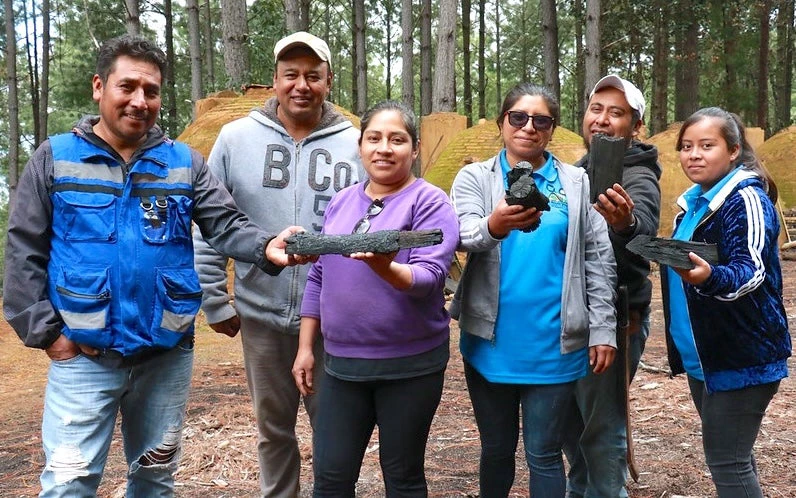 Visita a proyectos productivos asociados a la elaboración de carbon vegetal en Oaxaca, México. Foto: Banco Mundial / Jessica Belmont
Visita a proyectos productivos asociados a la elaboración de carbon vegetal en Oaxaca, México. Foto: Banco Mundial / Jessica Belmont
In Mexico, sustainably and inclusively investing in natural resource management could create jobs and prevent environmental degradation. Despite some progress, significant gender gaps persist in this area. In 2020, only 1.15 percent of the funds of Mexico's main forest sector support program were allocated for exclusively women-led projects. Also, funds directed to communities are likely managed mostly by men. To close this gap, programs need to be designed in a way that encourage women to apply, support them to succeed in getting the funds, and manage their projects.
Following diagnostics that identified structural and behavioral barriers for women, a multidisciplinary team, including gender, environment, and behavioral science experts, explored how to encourage women in rural areas of Mexico to engage in a call for proposals.
How to close the gender gap
To increase women’s engagement in a call for proposals in Yucatán and Oaxaca states, the team designed an experiment to test promising communication strategies. In this study, we randomly divided localities into three groups to test how well different dissemination strategies would work:
- Standard strategy: For this group, we used the standard strategies conducted by the call for proposals to let people know about the call, such as radio ads, involving community leaders, sharing brochures and posters, and organizing local meetings in large, central towns, where smaller locality representatives could also participate.
- Simplified, easier, and localized strategy: For this group, we made things simpler. They got a simplified, easy-to-understand poster design, a helpline, and experienced local people were employed to visit each locality and have up to two extra meetings to explain the application process.
- Behavioral science-informed message: In addition to the changes used for the previous group, we made further modifications. Here, we also sent reminders and informational messages using WhatsApp. We changed posters to also talk about social norms and directly encouraged women to apply by suggesting that many women have already applied and worked in these types of projects. The messages made it feel urgent, like they shouldn’t miss out. For example, “Now fill sections C and D of your application form! Don't miss the opportunity to participate! Call us, we'll help you out!” We also gave them a simple one-page checklist of the steps to apply. See Figure 1.
Results from this study suggest that making small changes in how we present the information can encourage more women to apply.
Figure 1. Posters using simplified, easier, and localized strategy and behavioral science-informed messages
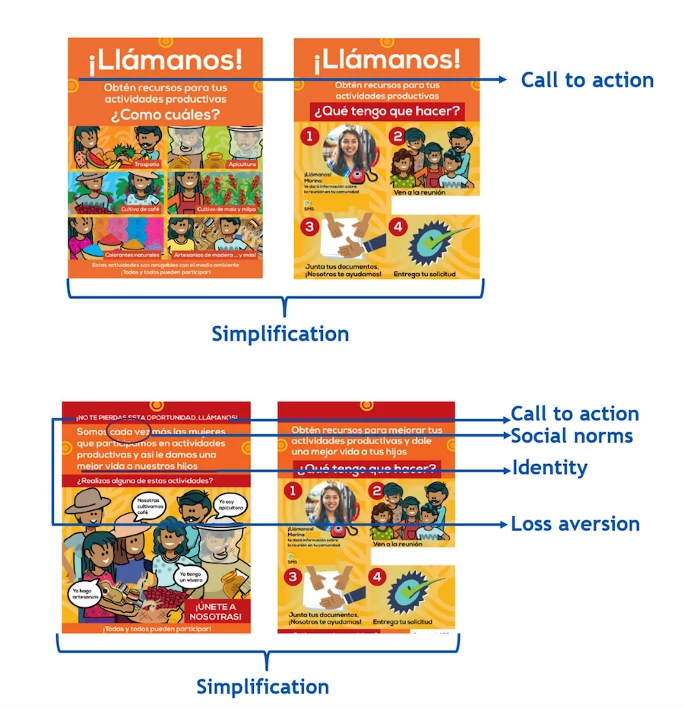
Successful women-centered communication strategies
The changes we made to how we spread the word about the project led to more people, both men and women, applying. Also, more women got to learn about the program and applied. In the specific areas we targeted with complementary strategies, women were more likely to have heard about the project and seen the information, compared to the areas where we did not make these changes.
In addition, the places where we used messages based on behavioral sciences (Group 3) had even more women applying compared to those that did not get these messages (Group 2 and the areas that received the standard strategy).
This suggests that when we challenge traditional ideas about what women can do and focus on their strengths and abilities, more women feel motivated to apply. Still, although the pilot strategies increased interest in grants and the number of applications, they did not increase the chances of an application receiving the grants.
Figure 2. How to better reach rural women: Findings from a communication strategy in Mexico informed by behavioral science
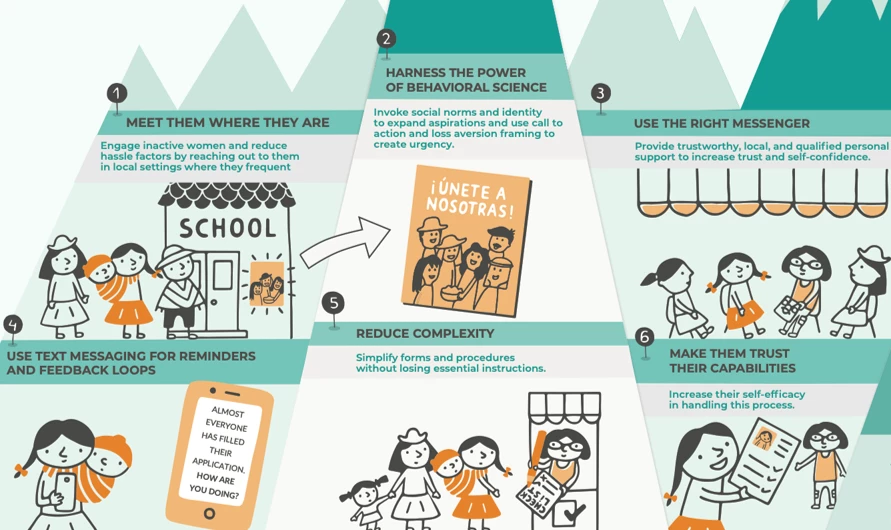
Three ways to ensure that future government and nonprofit organization projects are better designed to meet women’s needs:
- Understand and incorporate women’s perspectives: It is important to understand how to reach women, where they are, and what motivates and inspires them to participate proactively.
- Use targeted and clear materials: Providing materials that are well targeted and easy to understand can boost participation among those with lower education levels, time constraints, and facing language, cultural, or normative barriers.
- Replicating success: Government and nonprofit stakeholders can adopt and replicate this approach by expanding communication channels, simplifying information, and using messaging informed by behavioral science. This can help them effectively overcome gender-based barriers and reach under-represented populations.
Read our infographic, results brief, and report, visit our website, and learn more. We look forward to seeing the impacts that such strategies can have for job creation, income generation, and conservation.
The team partnered with the Climate Investment Funds (CIF), the Rainforest Alliance, and the National Lab for Public Policies at the Mexican Center for Research and Teaching in Economics (CIDE) to research what motivates or prevents women from accessing and participating in Natural Resource Management programs. This effort was funded by the CIF’s Evaluation and Learning Initiative, with additional financing from the Forest Carbon Partnership Facility (FCPF).
Subscribe and receive a weekly article
Related articles


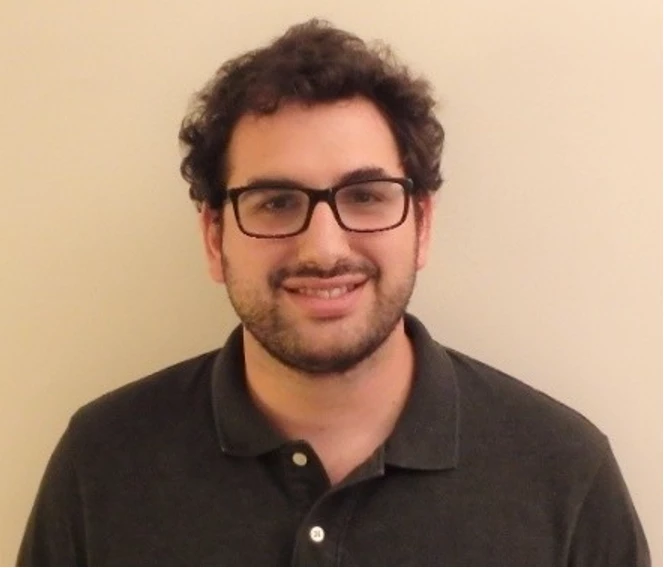

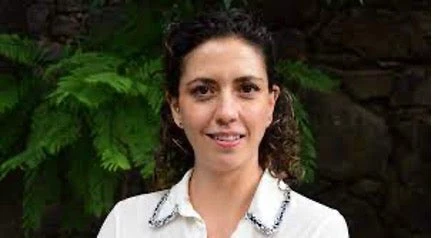
Join the Conversation